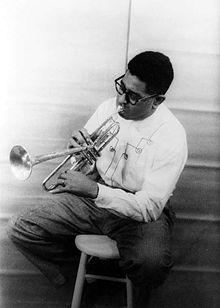Piano Sheets > Dizzy Gillespie Sheet Music > Groovin' High (ver. 2) Piano Sheet
Groovin' High (ver. 2) by Dizzy Gillespie - Piano Sheets and Free Sheet Music

About the Song
Other avaliable versions of this music sheet: Version 1 Version 2
"Groovin' High" is an influential 1945 song by jazz composer and trumpeter Dizzy Gillespie. The song was a bebop mainstay that became a jazz standard,[1] one of Gillespie's best known hits,[2] and, according to Bebop: The Music and Its Players author Thomas Owens, "the first famous bebop recording".[3] The song is a complex musical arrangement based on the chord structure of the 1920 standard "Whispering" by John Schonberger.[2] The biography Dizzy characterizes the song as "a pleasant medium-tempo tune" that "demonstrates...[Gillespie's] skill in fashioning interesting textures using only six instruments".[2]
The song has been used to title many compilation albums and also the 2001 biography Groovin' High: The Life of Dizzy Gillespie.[4]
First published on the 1945 album Shaw 'Nuff,[5] the song is one of seven on that album that, according to jazz critic Scott Yanow, "shocked" Gillespie's.
Download this sheet!
About the Artist

Random article
Everything about piano sheet music Sheet music has a history of its own, dating back to the 19th century. In those days, musicians would play classic compositions using sheet music piano. Later on, when bands started performing, music sheets were back in vogue as a means to recreate these old compositions.
What is it?
Sheet music is nothing but a written notation of the piano notes. Depending on what musical composition the sheet music is for, the musical notes written will also differ. Most people have a wrong notion that it is only the popular compositions, which have recorded onto sheet music piano. However, several unfamiliar compositions have also been recorded using sheet music.
(More...)
